Study shows that relative abundance of both juveniles and adults was variable across years but displayed no trend throughout the time series

The Crevalle jack (Caranx hippos) is a large, migratory fish found in coastal waters along both sides of the Atlantic Ocean in temperate, subtropical and tropical waters. The species, common in the southeastern United States and Gulf of Mexico, is a diurnal predator and mainly piscivorous as adults, while juveniles consume a variety of fish and invertebrates. Crevalle jack support both recreational and commercial fisheries, with the recreational fishery being particularly important in the United States.
The species is currently unregulated for both the commercial and recreational fisheries in all U.S. Gulf Coast states and federal waters. Crevalle jack are sought after for their fighting ability and the fishery is generally catch-and-release. Recently, concern from anglers about declining populations has prompted work on the abundance and life history of this species.
Despite increasing stakeholder concern, the Crevalle jack remains a relatively data-poor species and many of the recent efforts to describe its biology and fishery have focused on northern and eastern Gulf of Mexico populations. In the western Gulf of Mexico, little is known about Crevalle jack despite their common occurrence. Addressing these data gaps will be necessary to allow for effective fisheries management of this important fish species in the future.
This article – summarized from the original publication (Getz, E. et al. 2024. Seasonality, distribution, and harvest trends of Crevalle Jack in Texas. Marine and Coastal Fisheries Volume 16, Issue 1, February 2024, e10284) – presents the results of a study to describe Crevalle jack population trends, characterize the fishery, and identify potential seasonal trends that could aid in future management strategies for this species in Texas, USA.
Study setup
Crevalle jacks were collected in estuarine waters along the Texas coast as part of the Texas Parks and Wildlife Department (TPWD) Fisheries-Independent Sampling Program. Data were collected from 1983 through 2021 using bag seines, bay trawls, and gill nets deployed in each of the major bay systems along the Texas coast. All sampling sites were selected using a stratified random design by month and major bay. Crevalle jacks were enumerated and measured (total length, TL).
For each sample containing Crevalle jacks, up to 19 randomly selected individuals were measured and the rest were counted before being released. Latitude, longitude and depth were recorded at each sampling site; water characteristics, including temperature, salinity and dissolved oxygen were recorded. Depth was measured at the deepest point in all gear deployments, a water sample was collected and turbidity was measured using a turbidimeter.
Crevalle jack that were observed in fishery-independent sampling were used to assess patterns in both juvenile and adult relative abundance, distribution and seasonality. In addition, boosted regression tree models were used to highlight important predictors of Crevalle jack presence. Fish harvests observed during angler surveys was used to describe the fishery, including differences in inshore and offshore catch patterns
For detailed information on the study design, fish and data collections, and data analyses, refer to the original publication.
Results and discussion
Our results showed that Crevalle jacks used Texas estuaries during all life stages based on fishery-independent sampling data. These findings were consistent with reports by other researchers of juvenile fish selectively inhabiting in-shore environments, such as bays, passes, estuaries and brackish lakes. However, other previous studies have indicated that adult Crevalle jacks in the Gulf of Mexico remain offshore and are seldom encountered in in-shore waters. Based on the frequent occurrence of large fish (>950 mm total length, TL) observed in gill nets, Texas bays appear to be more commonly utilized as habitat by adults than previously thought.
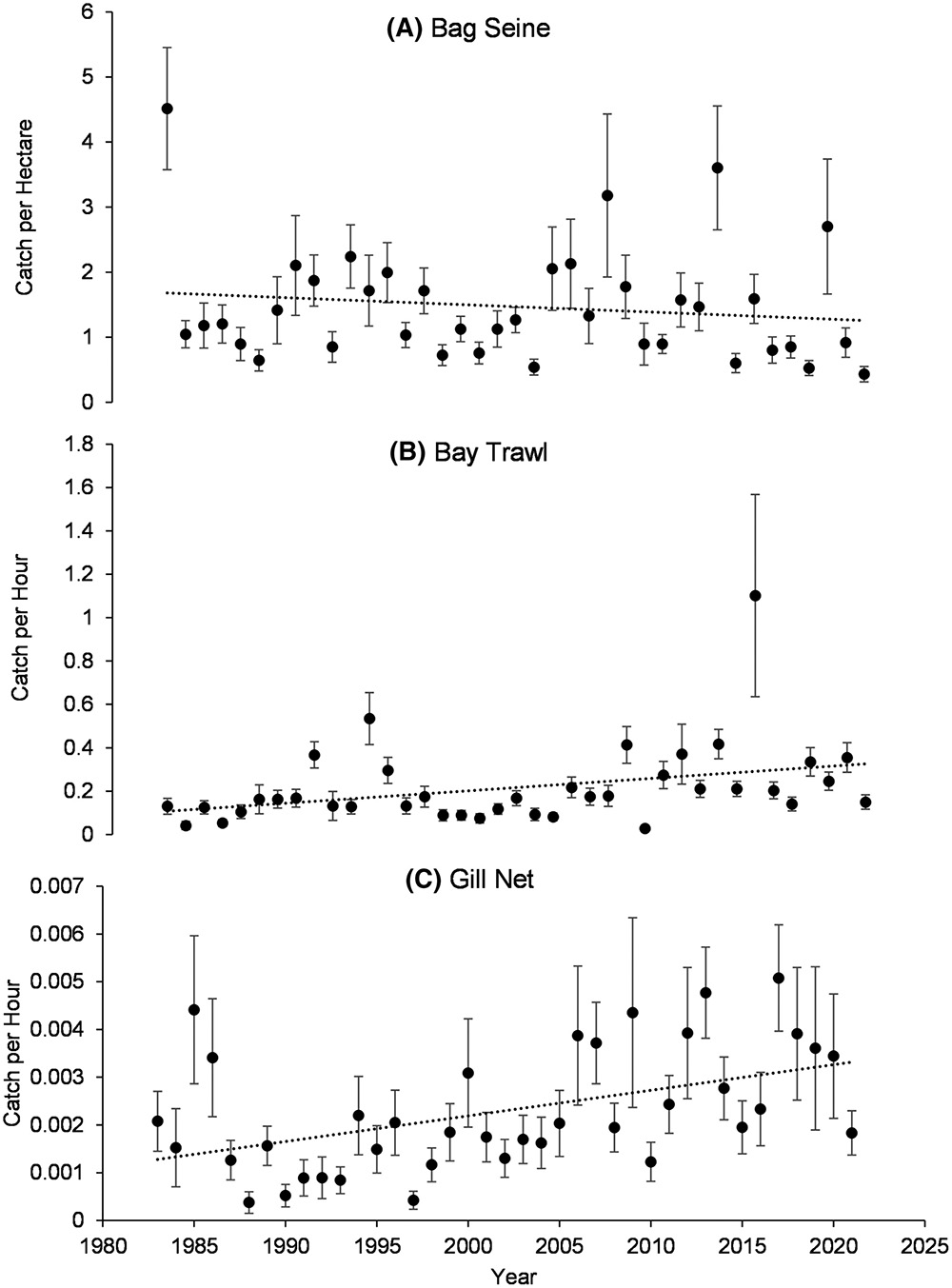
Although Crevalle jack of all sizes used in-shore waters, there were distinct peaks in the abundance of subadults (200–550 mm TL) and very large adults (>950 mm TL). Adults (550–950 mm TL) were encountered far less frequently in gill nets. These results are similar to those reported from Alabama’s fishery-independent gill-net surveys, which included a relative lack of mid-sized adults. Since gill nets used in our study included four specific mesh sizes, it is possible that gear selectivity could have contributed to the lack of certain size classes. However, a similar pattern was observed in the length frequency distribution of fish that were harvested by anglers in in-shore waters.
Scientists have noted size differences in Crevalle jacks across sampling locations, with larger adults observed in Alabama compared to Florida. They postulated that this trend could be driven by ontogenetic shifts in which subadults residing in Florida migrate north as adults. The maximum size of adults (1,608 mm TL) reported here was much larger than those reported in previous studies. Ontogenetic differences in movement could be explored further in Texas, with particular attention to large adults that are not reported in other parts of the range.
Adults sampled during spring in gill nets were also larger than those encountered during the fall, suggesting the occurrence of size-class-specific movements into and out of estuaries. Length frequency distributions from fishery-independent and fishery-dependent data sets suggest that mid-sized adult Crevalle jack (550–950 mm TL) are relatively less reliant on estuarine environments in Texas and may move offshore or to other areas of the Gulf of Mexico. The large adults (>950 mm TL) recorded here made up the majority of offshore landings based on angler creel data but were commonly harvested from in-shore waters as well. The apparent return of large adults to Texas bays based on presence in gill-net samples represents an avenue for future research and may be better understood by examining the presence of a preferred prey species like the Gulf menhaden.
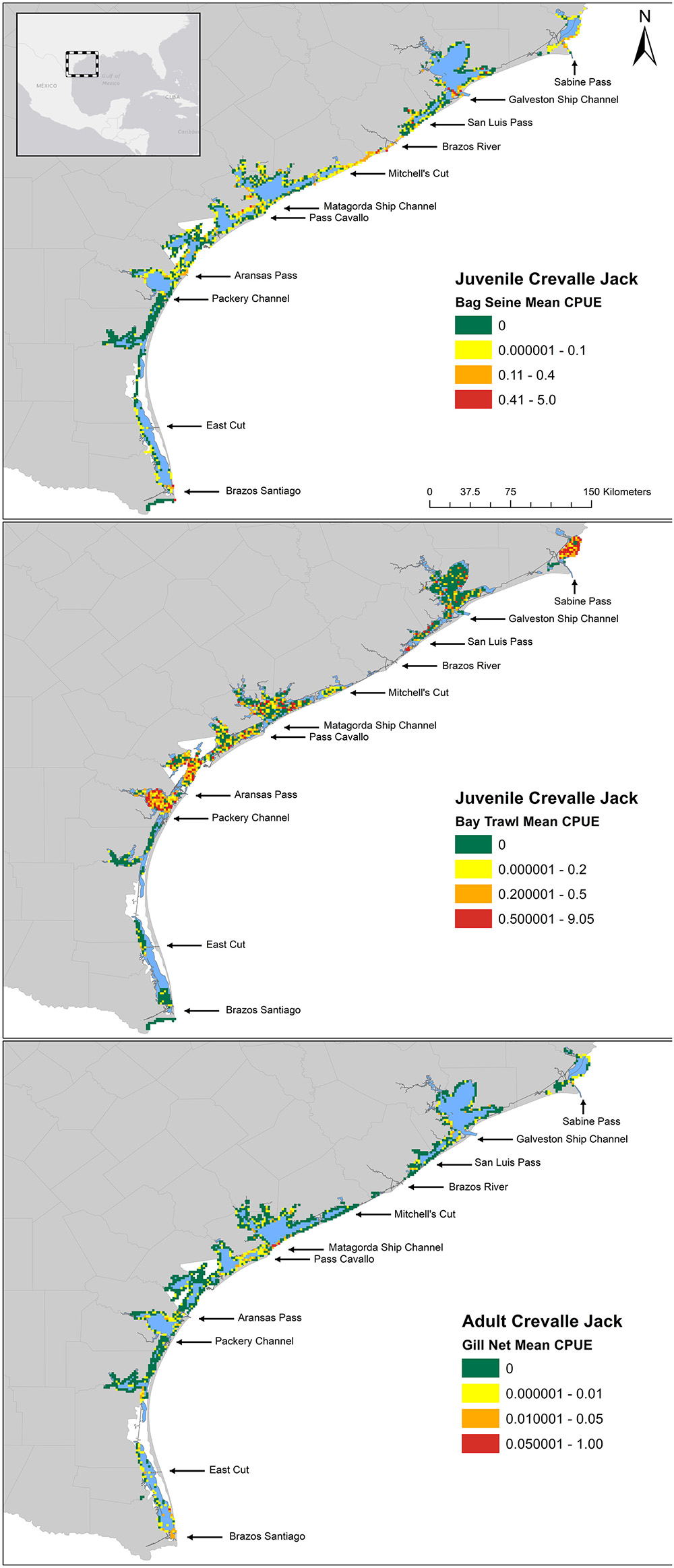
Dispersion patterns recorded in the present study were broad, with juveniles recruiting in all bays along the Texas coast. Juvenile occurrence in both bag seine and bay trawl samples varied across bay systems, but trends in occurrence by latitude were not clear. Distance to pass was one of the most significant predictors of juvenile presence in bag seine samples, suggesting that once larvae enter inshore waters, they do not travel far before settling. In general, seasonality and temperature seemed to be larger drivers of juvenile occurrence than location. These results suggest that Texas estuaries may function as nursery habitats for Crevalle jack, even though more work is necessary to describe preferred habitat characteristics.
Adult fish were distributed along the coast but were generally associated with passes. Similar to juveniles, adult occurrence was also influenced by temperature, with presence generally observed where water temperature was greater than 15 degrees-C. These results are similar to those reported by other researchers who have reported that most adults occur in temperatures between 18.0 and 33.6 degrees-C.
Month was an important predictor of Crevalle jack presence, and patterns in seasonality were clear in both fishery-independent and fishery-dependent data sets. The species is thought to spawn over outer shelf waters during the summer in the western Atlantic. Spawning season was not directly addressed here, but juveniles recruited to Texas estuaries and were observed in bag seines throughout the summer. Abundance of juveniles peaked in June, suggesting that spawning activity likely centers around late spring/early summer.
Adult seasonality was difficult to assess with fishery-independent sampling methods since gill-net samples were only collected during the spring and fall. Future research efforts that examine migration and spawning patterns of Crevalle jack are warranted throughout the Gulf of Mexico and could focus on defining critical spawning habitats.
The Crevalle jack recreational fishery has grown throughout the Gulf of Mexico, primarily with catch-and-release effort from anglers. Future population assessments should seek to fully describe the fishery by gauging angler interest in targeting this species for both catch-and-release and retention purposes. In addition, managers should understand that Crevalle jack harvest may be influenced by the availability of more desirable species.
Perspectives
Results of this study provide important population trends for Crevalle jack in the northwestern Gulf of Mexico and can inform future fisheries management strategies for the species in Texas and possibly throughout its range. Compared to more heavily targeted species, the harvest of Crevalle jack was relatively low in Texas, and abundance was consistent throughout the time series based on fishery-independent sampling effort. These results suggest that populations are less at risk of decline in Texas compared to other areas, like Florida’s Gulf Coast. Crevalle jack were common inshore and have been documented as one of the most abundant species on Texas artificial reefs.
Other researchers also documented Crevalle jack as one of the largest species observed on artificial reefs during roving diver surveys. Other large species – such as the greater amberjack, black grouper and cobia – are more desired as food fish but are also heavily managed. The Crevalle jack fishery is primarily catch and release and could provide anglers with an option for targeting a large, hard-fighting species. In addition, their presence in inshore waters and their affinity for offshore artificial reefs may make them easily accessible for relatively inexperienced anglers.
While seasonality and distribution patterns were described here, detailed migration and spawning patterns for Crevalle jack remain relatively unexplored. This is a highly migratory species in other parts of its range, and effective management strategies in the western Gulf of Mexico may consider stakeholder input and binational coordination. Evidence for shifting recruitment seasonality observed here indicates that a broader ecosystem understanding is required to effectively manage the species as well. In general, the Crevalle jack is an important predator and could become increasingly relevant as a coastal sport fish in both the inshore and offshore waters of Texas.
Now that you've reached the end of the article ...
… please consider supporting GSA’s mission to advance responsible seafood practices through education, advocacy and third-party assurances. The Advocate aims to document the evolution of responsible seafood practices and share the expansive knowledge of our vast network of contributors.
By becoming a Global Seafood Alliance member, you’re ensuring that all of the pre-competitive work we do through member benefits, resources and events can continue. Individual membership costs just $50 a year.
Not a GSA member? Join us.
Author
-
Ethan Getz, M.S.
Corresponding author
Texas Parks and Wildlife, Coastal Fisheries Division, Upper Laguna Madre Field Office, Corpus Christi, Texas, USA[118,111,103,46,115,97,120,101,116,46,100,119,112,116,64,122,116,101,103,46,110,97,104,116,101]
Tagged With
Related Posts
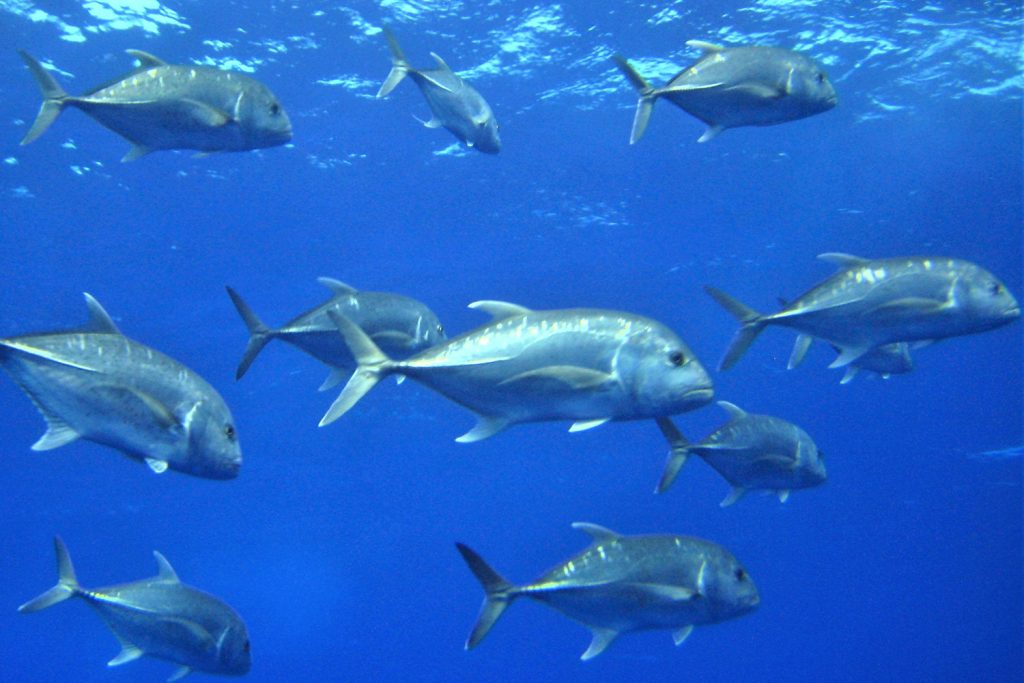
Aquafeeds
Evaluating the effect of dietary protein and lipid on the growth performance of juvenile giant trevally
In this trial, the growth performance of juvenile giant trevally was the highest when the fish were fed a 52 percent protein, 10 percent lipid diet.
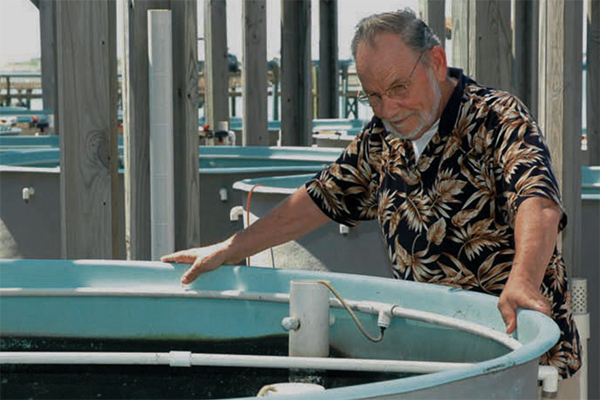
Intelligence
Addison Lawrence, dedicated shrimp aquaculture researcher, remembered
Dr. Addison Lee Lawrence, a well-known shrimp aquaculture researcher who authored or co-authored many Advocate articles, passed away in October at the age of 86.
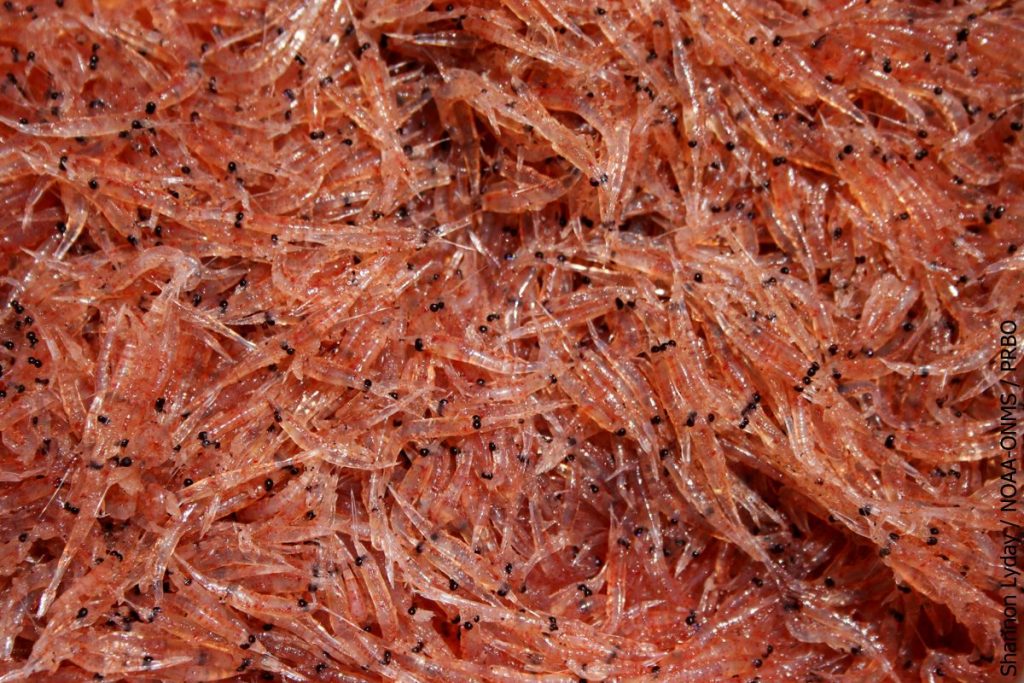
Fisheries
A review of bycatch in the Antarctic krill trawl fishery
Understanding the significance of bycatch is critical to managing Antarctic krill, a keystone species and the largest fishery in the Southern Ocean.
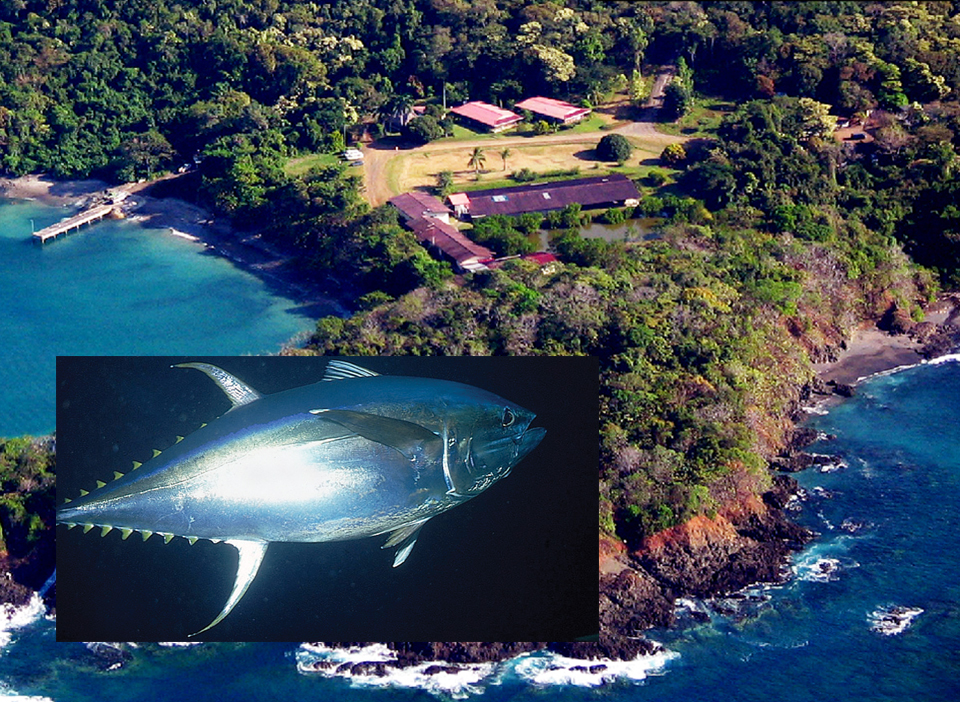
Health & Welfare
Achotines laboratory home to continuing studies of tuna early life history
The Inter-American Tropical Tuna Commission Achotines Laboratory in southern Panama is the world’s only facility with nearly year-round availability of tuna eggs and larvae. A study is comparing the reproductive biology, genetics and early life history of yellowfin and Pacific bluefin tuna.



